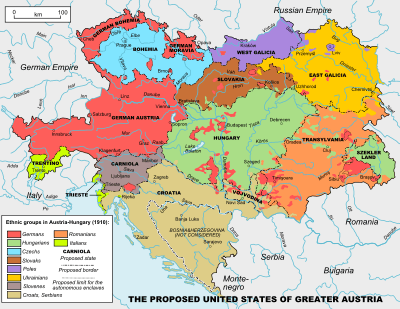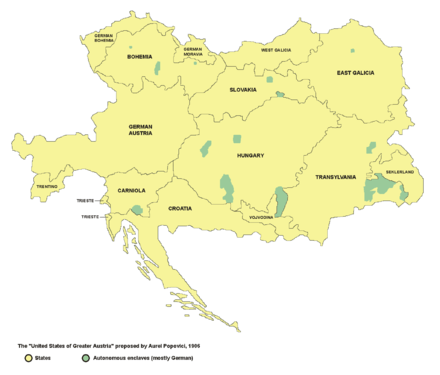United States of Greater Austria

The United States of Greater Austria (German: Vereinigte Staaten von Groß-Österreich) was a proposal, conceived by a group of scholars surrounding Archduke Franz Ferdinand of Austria, that never came to pass. This specific proposal was conceived by the lawyer and politician Aurel Popovici in 1906 and aimed at federalizing Austria-Hungary to help resolve widespread ethnic and nationalist tensions.
Nationality conflict
As the twentieth century started to unfold, the greatest problem facing the dual monarchy of Austria-Hungary was that it consisted of about a dozen distinctly different ethnic groups, of which only two, the Germans and Hungarians (who together accounted for about 44% of the total population), wielded any power or control. The other ethnic groups, which were not involved in the state affairs, included Slavic (Croats, Czechs, Poles, Ruthenians, Serbs, Slovaks, Slovenes and Ukrainians) and Romance peoples (Italians, Romanians). Among them, only Croats had limited autonomy in the Kingdom of Croatia and Slavonia. The idea of the Dual Monarchy system of 1867 had been to split the previous Austrian Empire into two realms, one German-dominated, the other Hungarian-dominated. However, after various demonstrations, uprisings and acts of terrorism, it became readily apparent that the notion of two ethnic groups dominating the other ten could not survive in perpetuum.
Franz Ferdinand had planned to redraw the map of Austria-Hungary radically, creating a number of ethnically and linguistically dominated semi-autonomous "states" which would all be part of a larger confederation renamed the United States of Greater Austria. Under this plan, language and cultural identification was encouraged, and the disproportionate balance of power would be corrected. The idea was set to encounter heavy opposition from the Hungarian part of the Dual Monarchy, since a direct result of the reform would have been a significant territorial loss for Hungary.
However, the Archduke was assassinated at Sarajevo in 1914, triggering the outbreak of the First World War. After the war, Austria-Hungary was dismantled and several new nation-states were created, and various Austro-Hungarian territories were ceded to neighbouring countries by the victorious Entente powers. However, many of the new national borders drawn immediately after World War I or afterwards approximately follow the proposed borders of the various states of the proposed United States of Greater Austria.
States proposed by Aurel Popovici
The first program for the federalisation of the Habsburg Empire was developed by the Hungarian nobleman Wesselényi Miklós. In his work titled "Szózat a magyar és a szláv nemzetiség ügyében" and published in Hungarian in 1843 and in German in 1844, he proposed not only social reforms but reforms of the state structure of the Empire its nationality policy. He aimed to replace the centralized empire with a federation of five states: a German state (containing the Slovene provinces as well), a state of Bohemia and Moravia, Galicia as a Polish state, and the state of historical Hungary (including Croatia).[1]
According to Popovici's plans, the following territories were to become states of the federation after the reform. The majority ethnic group within each territory is also listed.

- Deutsch-Österreich: German-Austria (present-day Austria with the Italian province of South Tyrol, the Bohemian Forest and South Moravia regions—the southern part of the later Sudetenland—in the present-day Czech Republic, as well as the Burgenland region in western Hungary including Ödenburg, Wieselburg and Pressburg), ethnic German
- Deutsch-Böhmen: German Bohemia (Sudetenland territory in northwestern Bohemia, present-day Czech Republic), ethnic German
- Deutsch-Mähren: German Moravia (northeastern Sudetenland in Moravia and Austrian Silesia, present-day Czech Republic, later named Province of the Sudetenland), ethnic German
- Böhmen: Bohemia proper (southern and central part of Bohemia and Moravia in the present-day Czech Republic), ethnic Czech
- Slowakenland: roughly present-day Slovakia, ethnic Slovak
- West-Galizien: West Galicia (the western part of the Kingdom of Galicia and Lodomeria in present-day Poland), ethnic Polish
- Ost-Galizien: East Galicia (the eastern part of the Kingdom of Galicia and Lodomeria and the adjacent Bukovina lands, in present-day Ukraine and Poland), ethnic Ukrainian
- Ungarn: Hungary (present-day Hungary with southern Slovakia and the northern Vojvodina region in present-day Serbia), ethnic Magyar
- Seklerland: Székely Land (part of present-day Romania), ethnic Magyar
- Siebenbürgen: Transylvania, the Banat and most of Bukovina (part of present-day Romania and Ukraine), ethnic Romanian
- Trento: Trentino (part of present-day Italy), ethnic Italian
- Triest: Trieste and Gorizia, parts of present-day Italy, western Istria, part of present-day Croatia and Slovenia), ethnic Italian and Slovenian
- Krain: Carniola (roughly present-day Slovenia with the Slovene-speaking territory of southern Carinthia), ethnic Slovene
- Kroatien: Croatia (present-day Croatia, Srem in present-day Serbia and Boka Kotorska in present-day Montenegro), ethnic Croatian and Serb
- Woiwodina: Vojvodina (part of present-day Serbia and Croatia), ethnic Serb and Croatian.
In addition, a number of mostly German-speaking enclaves in eastern Transylvania, the Banat and other parts of Hungary, southern Slovenia, large cities (such as Prague, Budapest, Lviv, and others) and elsewhere were to have autonomy within the respective territory.
“The great origin, language, customs and mentality diversity of different nationalities requires, for the whole Empire of the Habsburgs, a certain state form, which can guarantee that not a single nationality will be threatened, obstructed or offended in its national political life, in its private development, in its national pride, in one word – in its way of feeling and living”
Aurel Popovici (1906)
See also
- National personal autonomy, an alternative reform suggested by Austrian Marxists
References
- Isac, Iulian Nicusor. The United States of Greater Austria – a step towards European Union? (PDF). Retrieved 10 December 2009.
- Kowalski, Erich (2005). Die Pläne zur Reichsreform der Militärkanzlei des Thronfolgers Franz Ferdinand im Spannungsfeld von Trialismus und Föderalismus (in German). Vienna: Universitätsbibliothek Universität Wien.
- Popovici, Aurel (1906). Die Vereinigten Staaten von Groß-Österreich. Politische Studien zur Lösung der nationalen Fragen und staatrechtlichen Krisen in Österreich-Ungarn (in German). Leipzig.
- Teslaru-Born, Alina (2005). Ideen und Projekte zur Föderalisierung des Habsburgischen Reiches mit besonderer Berücksichtigung Siebenbürgens 1848–1918 (Inauguraldissertation) (PDF) (in German). Frankfurt am Main: Johann-Wolfgang-Goethe-Universität zu Frankfurt am Main. Retrieved 10 December 2009.
- ↑ ROMSICS Ignác: A Habsburg Birodalom föderalizálási tervei. In: Európai Utas 2001. IV. sz. http://www.hhrf.org/europaiutas/20014/4.htm